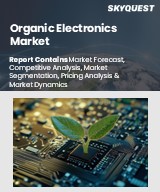
Report ID: SQMIG45O2046

Report ID:
SQMIG45O2046 |
Region:
Global |
Published Date: November, 2024
Pages:
194
|
Tables:
96 |
Figures:
66
Global Organic Electronics Market size was valued at USD 59.90 Billion in 2022 and is poised to grow from USD 71.22 Billion in 2023 to USD 239.27 Billion by 2031, growing at a CAGR of 18.9% in the forecast period (2024-2031).
It is expected that applications such as smartphone displays, colored light sources, portable solar cells, and curved HD TV will have a high impact on the global organic electronics market during the forecast period. Organic electronics are predicted to provide more functionality for the duration of the forecast period as it tries to resolve the power consumption concerns. This makes them very promising technology. Applications of organic electronics might be found in many areas such as IT, biological research, environmental health, or national security. They will probably appear as a low-cost variant for traditional inorganic electronic applications because their production techniques are simple, and the material consumption is limited. Over the projection period, the development of complex systems on the basis of organic semiconductors may demonstrate those devices' exceptional technological maturity and competitiveness. Organic materials have a greater capability to interface with biological systems compared to inorganic material. The enhanced biocompatibility of organic material has also led to biomedical applications, such as neuron interfacing. Transparent organic transistors can simultaneously observe and replicate electrical activity from grown human neurons; maybe new possibilities for neurophysiology remain unparalleled. There are several factors that must stimulate the organic electronics market in the coming years, including a rapidly expanding consumer electronics market, significantly increasing application areas, favorable government initiatives, and better performance.
Our industry expert will work with you to provide you with customized data in a short amount of time.
REQUEST FREE CUSTOMIZATIONWant to customize this report? This report can be personalized according to your needs. Our analysts and industry experts will work directly with you to understand your requirements and provide you with customized data in a short amount of time. We offer $1000 worth of FREE customization at the time of purchase.

Report ID: SQMIG45O2046